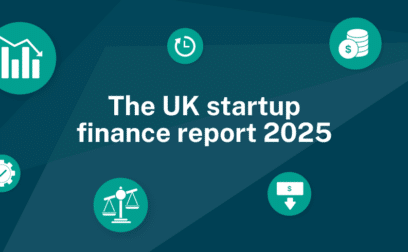Note: since April 1st 2023 the amount a business can receive in SEIS funding rose to £250,000, the amount an investor can contribute rose to £200,000, and the maximum age of the business able to take advantage of the scheme increased from 2 years to 3 years.
Raising startup and seed capital for young companies has always been difficult. Investors can be wary of entrepreneurs and untried ideas. The UK Government-supported Seed Enterprise Investment Scheme (SEIS) makes this process easier by giving generous tax relief to investors in new businesses. They invest, you get funding, they get a tax break. It’s a successful formula for all. Since its introduction in 2012, more than £1 billion has been raised for thousands of UK companies with SEIS. Get your new business off the ground with the investment scheme that does what it says on the tin.
What is the Seed Enterprise Investment Scheme (SEIS)?
The Seed Enterprise Investment Scheme (SEIS) is one of four venture capital schemes offered by the UK Government. SEIS is designed to attract investors to UK businesses that are less than three years old. The SEIS is a tax relief programme – it does not provide cash funding. By providing generous tax breaks to investors, the scheme makes it easier for companies to attract investment. Think of SEIS as a seed capital magnet. Not only do investors get a stake in your business they also get tax relief on their investment. A win/win situation.
Read more: the UK Government’s guidance on their four venture capital schemes.
How does SEIS work?
First introduced in 2012, the Seed Enterprise Investment Scheme helps small, early-stage companies raise seed capital from individual investors by providing tax relief on invested funds. In other words, SEIS helps you raise funds for your new company by giving your investors a generous tax break. Not only can they invest they can save money doing so. Additionally, SEIS offers loss relief. This means that should your company fail, investors can claim back some of their investment against future income tax liabilities. This will not fully reimburse investors, but it will soften the blow, providing an added incentive for them to invest.
SEIS is not a source of venture capital. It is an incentive. The government does not provide cash. Instead, SEIS provides tax relief to individual investors, (not companies), who buy shares in a qualifying business. This makes it easier for those companies to attract the investment they need.
The key elements of SEIS are:
- The company must be based in the UK and trading for less than three years
- It must be a qualifying trade or business. (Find out more on what the government defines as a qualifying trade)
- Investors can invest up to a maximum of £200,000 per individual per tax year
- Companies can accept a maximum of £250,000 in invested SEIS to qualify for tax relief
- The company cannot have received investment under other government venture capital investment schemes
- The company must be carrying out a new trade. It cannot have carried out a previous trade
- Invested funds must be spent on a qualifying activity within 3 years of investment
- Individual investors only. Corporations cannot invest in new businesses under SEIS
- Some venture capital funds run SEIS-specific funds where they will invest up to the £250,000 limit of a business. These funds pool together many investors SEIS allocations allowing them to make many investments
Swoop’s team of confidential advisors are available to discuss your funding needs. Register with Swoop to discuss how your new business can take advantage.
What is the minimum and maximum investment?
There is no minimum investment in SEIS. The maximum investment for investors is £200,000 per individual per tax year. SEIS companies can accept investment up to £250,000 total (invested funds beyond this sum do not qualify for SEIS tax relief).
What are the eligibility criteria?
Early-stage businesses wishing to participate in SEIS must:
- Be new or trading for less than three years
- Be a qualifying trade or business. (Find out more info. on what the government defines as a qualifying trade)
- Be established in the UK
- Not trading on a recognised stock exchange at the time of the share issue
- Not be preparing to become a quoted company or a subsidiary of one at the time of the share issue
- Not be in control of another company unless that company is a qualifying subsidiary
- Not be controlled by another company since incorporation
- Not have gross assets over £200,000 when the shares are issued
- Not be a member of a partnership
- Have less than 25 full-time equivalent employees in total when the shares are issued
Businesses that have already received investment through the Enterprise Investment Scheme (EIS) or from a venture capital trust, cannot use SEIS.
What if I’m not eligible for SEIS?
If you do not qualify for SEIS, don’t worry. Swoop can offer funding alternatives to make your business fly:
- You may be eligible for the EIS scheme, if your business has been trading for over 2 years. The EIS scheme is like the big brother or sister of SEIS, investors get a tax break of 30% of the value of their investment rather than the 50% of SEIS, but they are able to invest more.
- Government-backed startup loans – financial support from £500 up to £25,000, with a maximum of £100,000 available if four business partners or directors personally apply.
- Business loans – everything from unsecured and secured bank loans to asset finance loans that raise funds by using the hard assets of the business as collateral, and unsecured merchant cash advances that work for businesses that mostly get paid by customer debit or credit card
- Invoice finance – unlock the pent-up value in your unpaid invoices. Get paid now instead of 30, 60, or 90 days later
- Equity investment – no SEIS? No matter. Plug into Swoop’s equity finance network of angel investors, trusts, venture capitalists, family offices and more. Find the investors you need on terms to suit you.
Even if you’ve been rejected for funding elsewhere, Swoop may still be able to help you. Register with us to secure the seed capital your new business deserves.
What are the benefits of SEIS?
The Seed Enterprise Investment Scheme offers advantages to both company and investor:
For companies
SEIS gives a company the ability to raise equity investment that may be hard or impossible to secure as a seed-stage business. Eligible businesses can raise up to £250,000 under the scheme. Additionally, SEIS funding can be used to repay any third-party loans the business may have outstanding.
For investors
SEIS advantages for investors centre on tax relief and a degree of loss relief in the event the company fails. Key benefits are:
- Up to 50% income tax relief offset against the amount invested
- Capital gains tax (CGT) relief of 50% on investment in a non-SEIS company – if the gains from that investment are reinvested into an SEIS-eligible company
- No CGT payable for any gains from the SEIS investment if the shares are held for at least three years
- If the business fails, the investor can claim loss relief at their highest rate of income tax
- No inheritance tax payable on SEIS shares if they are held for at least two years
- Tax relief can be carried back to the previous tax year, providing that the investor had not already invested the maximum of £200,000 under SEIS in that year
SEIS – a simplified example
Assume that XYZ Tech Ltd needs to raise up to £250,000 in seed capital for its new app platform. After checking that their young business meets the eligibility criteria for SEIS, the directors apply to HMRC for Advance Assurance. If successful, they will receive notice from the tax man that says the investment is likely to qualify for SEIS. The company can show this statement to potential investors.
After successfully receiving Advance Assurance, the company pitches its concept to potential angel investors. Two decide to invest. The first offers £200,000, (the maximum they can invest in SEIS that tax year) and the second offers £50,000. This gives XYZ Tech the full investment they need.
The investors claim tax relief at an initial rate of 50%. Assuming they each have sufficient tax liability to claim the relief, this means their net investment is cut in half to £100,000 and £25,000, respectively. Their shareholding in XYZ Tech remains unaffected by this tax break.
What is Advance Assurance (AA)?
Investors seeking to invest in SEIS need to know the company they are investing in is eligible for the scheme. If it’s not, they will not get their tax breaks. Businesses can obtain proof of their eligibility for SEIS by seeking Advance Assurance from HMRC. (Advance Assurance will not tell the company if an investor is eligible for SEIS).
Applications for AA can be filed by the company secretary, a director, or a trustee if it the social enterprise is a charitable trust. They will need to provide details of potential investors as well as the following:
- Forecast of how much money you hope to raise
- Business plan and financial forecasts
- A copy of the latest accounts if available
- List of which companies will use the investments
- Details of all trading and activities to be carried out, plus an estimate of how much you expect to spend on each activity
- A list of any amounts, dates, and venture capital schemes under which you’ve previously received an investment
- Up to date copy of the memorandum and articles of association and details of any changes you expect to make
- A copy of the register of members from the date you apply for Advance Assurance
- Latest draft of any documents you use to explain your proposal to potential investors. (Your ‘pitch’ document)
- Details of any other agreements between the company and the shareholders or VCT
- A signed letter from one of your directors or trustees if you’re allowing an agent to act on your behalf
- A completed checklist for SEIS with your Advance Assurance application form
- Any other documents to show you meet the qualifying conditions for the scheme
HMRC will contact the applicant after they have made their decision. If their answer is positive, they will provide a statement that says the investment is likely to qualify for SEIS. This can be shown to potential investors. Note the word ‘likely’ in HMRC’s statement. It is an indication of eligibility, not a cast-iron guarantee. If HMRC declines to offer SEIS, they will usually say why.
Expect the adjudication process to take up to eight weeks.
How do I contact HMRC about my SEIS application?
To discuss an ongoing application, you can email HMRC at: enterprise.centre@hmrc.gov.uk although it may take up to two weeks to get a reply.
You can phone HMRC on 0300 123 3440. However, this is not a direct line, it is a messaging service. You can leave a message and HMRC will determine if a reply is needed. You will usually get an answer quicker by email than by calling.
Additionally, you can write to HMRC at:
Venture Capital Reliefs Team
HM Revenue and Customs
WMBC
BX9 1BN
What is the difference between SEIS and EIS?
Although SEIS and EIS both aim to draw investment into high-growth potential, smaller and younger UK companies, there is a critical difference between the two schemes. SEIS targets investment for early-stage companies, whereas EIS supports larger and more established businesses. There are other differences in qualification criteria, (see chart below).
(EIS has different criteria for Knowledge Intensive Companies – KIC – which are typically those with high research/development costs and requirements).
Read more: our in-depth comparison of SEIS and EIS.
| Key differences between SEIS and EIS venture capital investment programmes | ||
| SEIS | EIS | |
| Company location | UK | UK |
| Maximum trading age of business | 3 years | 7 years or 10 years for KIC |
| Maximum number of employees | 25 | 250 or 500 for KIC |
| Maximum gross assets | £200,000 | £15m |
| Maximum investment allowed | £250,000 | £12m or £20m for KIC |
| Corporate investors allowed | No | Yes, but no tax relief |
| Funds must be spent within | 3 years | 2 years |
| Initial tax relief rate | 50% | 30% |
| Capital gains tax relief | Yes | Yes |
| Loss relief | Yes | Yes |
SEIS or EIS? Talk to Swoop’s team of confidential advisors today to find out which scheme is best for your business.
Read more: our in-depth Enterprise Investment Scheme (EIS) guide.
SEIS rules for investors
There are complex rules for SEIS investors, but the key points are that the company you are investing in and the shares you receive in exchange for your investment are SEIS eligible, and as an investor you are eligible for these schemes. Failure to meet either of these important criteria may mean your tax breaks are denied or reduced by HMRC.
Other investor requirements include:
- You have UK taxable income. (You do not have to live in the UK)
- You are not an employee of the company you are investing in. (Although you can be a paid director).
- You cannot own more than 30% of the company’s stock within three years of the initial share issue. (This is also known as having a ‘substantial interest’)
- You cannot have any related investment arrangements. (This means no reciprocal investing with another shareholder)
- No linked loans. (You cannot have any loans from the company that are linked to your investment within three years of your initial share investment)
- You cannot use SEIS purely for tax avoidance
- You cannot invest more than £200,000 per tax year in an SEIS business
SEIS companies can be invested in directly or through an SEIS fund. Investors seeking to invest more than £200,000 in a young business, should consider the Enterprise Investment Scheme.
SEIS rules for companies
Early-stage businesses wishing to participate in SEIS must:
- Be new or trading for less than three years
- Be a qualifying trade or business. (Find out more info. on what the government defines as a qualifying trade)
- Be established in the UK
- Not trading on a recognised stock exchange at the time of the share issue
- Not preparing to become a quoted company or a subsidiary of one at the time of the share issue
- Not be in control of another company unless that company is a qualifying subsidiary
- Not be controlled by another company since incorporation
- Not have gross assets over £200,000 when the shares are issued
- Not be a member of a partnership
- Have less than 25 full-time equivalent employees in total when the shares are issued
Additionally, the offering shares must be paid-up in full when they’re issued. This means your company should have a way to accept payment before shares are issued. (Contact Swoop today to find the best business bank account for your new company).
Invested funds must be spent within three years of investment on either:
- A qualifying trade
- Preparing to carry out a qualifying trade
- Research and development that’s expected to lead to a qualifying trade
You cannot use the investment to buy shares, unless the shares are in a qualifying 90% subsidiary that uses the money for a qualifying business activity.
Businesses that have already received investment through the Enterprise Investment Scheme (EIS) or from a venture capital trust, cannot use SEIS.
SEIS and capital gains tax (CGT) deferral
When you make a gain from selling or disposing of an asset that has increased in value, capital gains tax (CGT) becomes payable. CGT is paid for the tax year in which you dispose of the asset.
Capital gains made on the disposal of an asset CANNOT be deferred in SEIS. However, even though deferral is not an option, there are still two CGT reliefs available within SEIS. These are reinvestment relief and disposal relief.
Reinvestment relief is available when gains arising on the disposal of any asset are reinvested in shares in a company on which SEIS Income Tax relief is received. The maximum amount of reinvestment relief that can be claimed is £50,000.
Disposal relief enables the disposal of SEIS shares without payment of capital gains tax – if the following conditions are met:
- You must have received SEIS Income Tax Relief in full on the whole of your subscription for the SEIS shares and none of the Income Tax Relief must have been withdrawn
- You must have held the SEIS shares for at least 3 years
How long does SEIS last?
Deadlines affect SEIS in two different ways – claiming income tax relief on investment, and the expiry point of a company’s Advance Assurance from HMRC.
- Businesses are only eligible for SEIS assurance up until 2 years after they first start trading. So make sure you use this before your time runs out.
- Claiming tax relief
Investors can claim income tax relief for up to five years from 31st January in the year after the investment was made. For example, an investor making an investment in SEIS during June 2021 will have five years from 31st January 2022 to claim their tax break.
- Expiry of Advance Assurance
There is no expiry point of an Advance Assurance statement from HMRC. However, think of AA as an indication of eligibility for SEIS, not a cast iron guarantee. Your AA statement is only as good as the information you provided to obtain it. If you omitted something significant at the time of application, or if there have been significant changes in your business by the time of investment, your company may fall outside eligibility, regardless of the fact you have been given Advance Assurance by HMRC.
How to claim SEIS loss relief
A key advantage of SEIS is the ability for investors to claim loss relief. This means that if the shares they bought in an SEIS business are sold at a loss, or if the company fails, the investor can claim back the loss against income tax or capital gains tax at their appropriate tax rate. (Up to a maximum of 50%). Shares that are sold at a loss within three years of purchase do not qualify for loss relief, however, where the company is wound up and total loss is incurred, loss relief is available even within the three years holding period.
Investors can claim loss relief on the year of the loss, then offset the loss against their current tax bill or the one for the previous year. Relief can be set against income tax or CGT.
What is SEIS reinvestment relief?
SEIS reinvestment relief allows an investor to reduce their liability for capital gains tax (CGT) by up to 50% by reinvesting some of the profits they make by selling shares in an SEIS company into a different SEIS eligible business. It works like this:
Sally invests £10,000 in an SEIS qualifying company. After three years, she sells her shares for £20,000, making a capital gain (profit) of £10,000. Normally, this profit would be liable for capital gains tax. However, current tax rules allow Sally to reinvest up to 50% of her profit in a different SEIS eligible business and pay no CGT on the sum she reinvests. If Sally reinvested the full 50%, or £5,000, she only pays CGT on half, (£5,000) of her profits.
The maximum that can be claimed for SEIS reinvestment relief is £50,000.
How to claim/apply for SEIS
Meeting the requirements of SEIS to make your company most attractive to investors can be tricky. Small mistakes can have big consequences. Our team of confidential advisors can walk you through the process to achieve the optimum outcome.
Let Swoop give your new business the best possible start. Register your business and take advantage today.
Swoop requires writers to use primary sources to support their work. These include white papers, government data, original reporting, and interviews with industry experts. We also reference original research from other reputable publishers where appropriate.
- 4 types of Government venture capital scheme: https://www.gov.uk/guidance/venture-capital-schemes-raise-money-by-offering-tax-reliefs-to-investors
- Qualifying trades: https://www.gov.uk/guidance/venture-capital-schemes-raise-money-by-offering-tax-reliefs-to-investors#trades
- Recognised stock exchange: https://www.gov.uk/guidance/recognised-stock-exchanges
- Qualifying subsidiary: https://www.gov.uk/guidance/venture-capital-schemes-apply-for-the-enterprise-investment-scheme#subsidiary
- SEIS Investor rules: https://www.gov.uk/government/publications/seed-enterprise-investment-scheme-income-tax-and-capital-gains-tax-reliefs-hs393-self-assessment-helpsheet/hs393-seed-enterprise-investment-scheme-income-tax-and-capital-gains-tax-reliefs-2017
- EIS: https://www.gov.uk/guidance/venture-capital-schemes-apply-for-the-enterprise-investment-scheme
- SEIS statistics: https://assets.publishing.service.gov.uk/government/uploads/… May_2020_Commentary_EIS_SEIS_SITR_National_Statistics.pdf
- Loss and Reinvestment relief: https://www.gov.uk/government/publications/seed-enterprise-investment-scheme-income-tax-and-capital-gains-tax-reliefs-hs393-self-assessment-helpsheet/hs393-seed-enterprise-investment-scheme-income-tax-and-capital-gains-tax-reliefs-2020



































 yet? Register here!
yet? Register here!